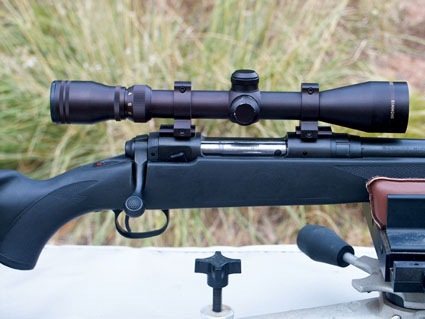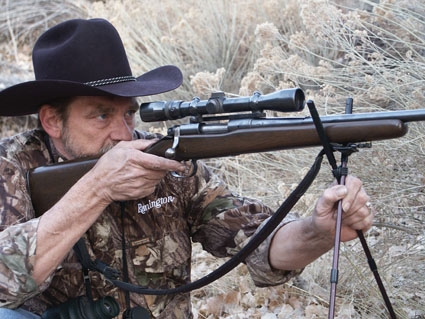 In the hunting community, you, the whitetail hunter, still pack the biggest clout. Ninety-five percent of all shots fired at big game in this country are fired at whitetails. Among this group, I’ll go out on a limb and say no more than 20 percent of all whitetail hunters are gun enthusiasts first and hunters second. The big majority probably are guys that live for the hunt and the challenge. To these hunters, the rifle is just a tool. They might think nothing of casually laying it aside when they get down to the important business of gutting, skinning and caping. After the season, they shove the gun in a case, stick it in the closet and don’t think much about it until the next opener.
In the hunting community, you, the whitetail hunter, still pack the biggest clout. Ninety-five percent of all shots fired at big game in this country are fired at whitetails. Among this group, I’ll go out on a limb and say no more than 20 percent of all whitetail hunters are gun enthusiasts first and hunters second. The big majority probably are guys that live for the hunt and the challenge. To these hunters, the rifle is just a tool. They might think nothing of casually laying it aside when they get down to the important business of gutting, skinning and caping. After the season, they shove the gun in a case, stick it in the closet and don’t think much about it until the next opener.
If you’re in this group, then this pre-season prep is for you. Don’t take your rifle for granted and expect it to function dependably without a little basic care. If you don’t follow at least the following few steps, it’s just a matter of time before you wind up with a calamity, an accident, or at the very least, an unfilled tag.
1. Unload It. Get the rifle, take it outside, point it in a safe direction, and make sure it is unloaded. Check the magazine, and most importantly, the chamber, before you touch that trigger.
2. Clean Out The Crud. Cycle the action. Work the bolt, pump or lever and make sure it’s working smoothly with no crud in the action area left over from last season. If you use a bolt-action and you don’t know how to take the bolt completely apart, take it to a gun shop and have it done. An untended bolt gets crud and oil buildup inside, and sooner or later it will shut you down. For just a few bucks, a shop will strip it and clean it in minutes. Do this every few seasons, or you’ll pay the price. Look carefully between the barrel and stock. If you even suspect there is dirt, or worse, rust hidden by the stock, then separate the two and clean the area. The underside of the barrel and portion of the receiver covered by the stock holds moisture and can rust away. Unless you separate them once in a while, you’ll never know it.
 3. Tighten The Scope. Check the sights, scope rings and bases for tightness. Rings and base screws will loosen up over time, so grab the scope and see if it has any movement. If it budges at all, pull the scope off and tighten the base screws. A dab of LokTite is good insurance on base screws. Make sure the scope won’t rotate or slide forward and back in the rings. Snug everything up with a screwdriver or Allen wrench. Tighten the covers on the scope adjustment turrets, because losing one is a real pain.
3. Tighten The Scope. Check the sights, scope rings and bases for tightness. Rings and base screws will loosen up over time, so grab the scope and see if it has any movement. If it budges at all, pull the scope off and tighten the base screws. A dab of LokTite is good insurance on base screws. Make sure the scope won’t rotate or slide forward and back in the rings. Snug everything up with a screwdriver or Allen wrench. Tighten the covers on the scope adjustment turrets, because losing one is a real pain.
4. Wipe Down The Optics. Find a soft rag, a little distilled water or lens cleaner, and thoroughly clean the glass on the scope. Dirty optics cut down light transmission and can cost you during low-light times. Clean the lenses thoroughly and add some anti-fog coating for good measure. It’s sold virtually anywhere camera or eyeglass supplies are available.
5. Check Your Ammo. See how many rounds of ammo you have left. If you’re down to just a few cartridges, it’s time to buy more of the same weight and brand you sighted-in with. You might need to check a few stores or have them ordered, but the time to acquire another box is now. If you unloaded the unused rounds from last year and put them in their original box, pull them out and check for corrosion. Blood can cause cases to corrode. Wipe them all down and put aside any that you have doubts about.
6. Snug Up The Receiver Screws. The two or three screws that hold your barrel and action to the stock will loosen over time. Tighten them. Some take an Allen head, but most just need a medium flat-head screwdriver.
7. Clean The Bore. Run a dry patch through the bore. If it’s really dirty, then for crying out loud, clean the barrel thoroughly. If you don’t want to mess with the job, then pay a few bucks and have it done. In any case, run a patch through to see if any creepy-crawlers built a web or nest in the bore. Spiders love such dark places, and I’ve even had mud daubers pack them solid on a few of the guns I keep in my truck. The last thing you want is rust starting in the bore. That’s the kiss of death for accuracy — a little oil is cheap and easy insurance.
8. Adjust The Sling. Find your sling, but before you put it on the rifle, get a nail or Allen wrench or anything small enough to fit in the sling stud holes and make sure they are tight. They loosen up quite frequently, and having a stud back out when you have the rifle shouldered usually results in a bad drop and guaranteed loss of zero. Check both studs, tighten them and install the sling.
9. Hit The Range. Check your zero by firing three rounds from your field-shooting position. Make sure the rifle is still hitting where it should, especially if you had to remove the stock or the scope. Fire from the same sitting, kneeling or the off-shooting-sticks position you normally use when hunting. Some rifles shoot very differently off a bench than they do from the hands.






